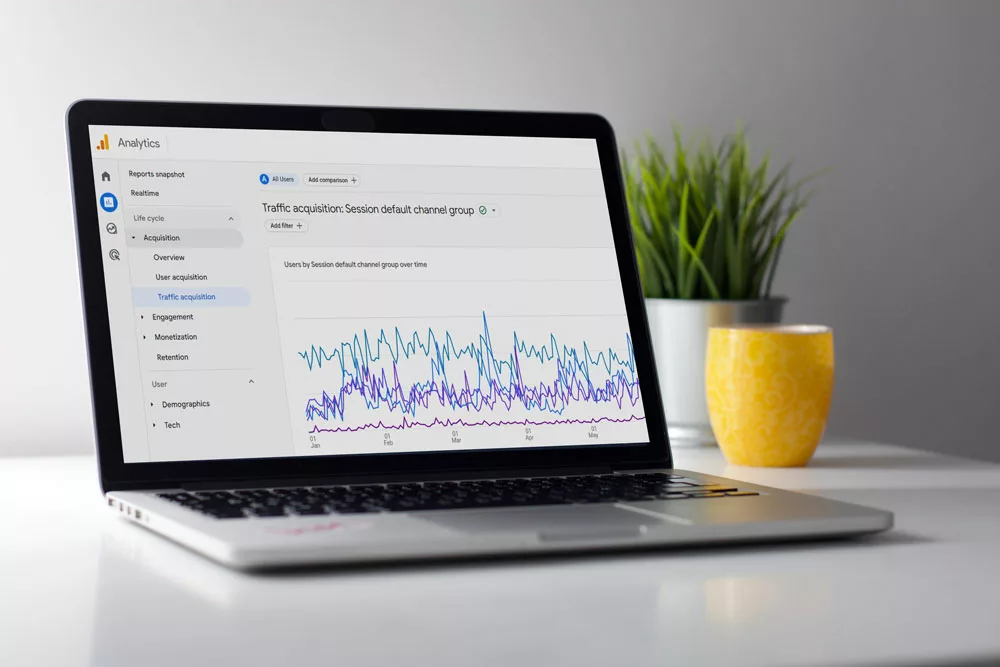Google will officially retire its flagship Universal Analytics (UA) on July 1, 2023. That means if you haven’t already made the switch to its replacement, Google Analytics 4 (GA4), time is running out to migrate your website analytics tracking to make sure you continue to collect the data you need. Not sure where to start? Read on for a breakdown of the basics.
What’s Different About GA4
First, let’s look at what’s different about GA4 compared to it predecessor UA. With the release of GA4, Google has evolved its overall approach to data collection and tracking. Some key differences include:
Event-Based Data
Probably the most fundamental change in GA4 is its model for measuring insights and data. Designed for a cookie-less world where user privacy protections are paramount, GA4 does not rely on cookies for tracking and it does not retain IP addresses. It uses an event-based model for tracking and analyzing the actions of users on your site. That means that the system is tuned to track individual actions like a page view or a link click as separate, individual events rather than one in a series of events as part of a single session like UA did. The result is more a holistic understanding of the user journey on your site as well as more privacy protection for individual users.
A New Focus on Measuring Engagement
GA4 takes a more user-focused approach to tracking engagement on your site. As a result one of the staple metrics of the UA-era, the bounce rate, is no longer a focus in GA4. In UA, the bounce rate represented the percentage of users on your website that did not interact with or view more than one page on your site. Instead, GA4 tracks your site’s engagement rate which is calculated as the percentage of sessions on the site that are deemed engaged sessions. According to Google, engaged sessions are those that last more than 10 seconds, have a conversion event (like making a purchase) or have at least two pageviews. So, the engagement rate is essentially the inverse of the bounce rate (which you can still find in GA4 if you want to), but gives us a user experience focused metric to understand how well your content is resonating with users. You’ll see a similar approach through other metrics in GA4. For example, average engagement time now replaces time on site.
Multiple Data Streams
GA4 allows for multiple data streams per property so data from multiple channels, for example your website and your app, can be pulled into one Analytics property for analysis all in one place.
Data Retention Options
As an extension of its privacy-focused approach, GA4 offers easier user data deletion as well as data retention options that allow the site admin to choose how long GA4 will store user data. Data retention for user-specific data is set to 2 months by default and may be extended to a maximum of 14 months. After that time, you can no longer access user-specific data in GA4.
Machine Learning
Google had already started to incorporate machine learning tools into UA and now in G4, the machine learning model is built right in. That means that the program will provide additional insights as well as predictive analytics – that is, forecasting of future user behavior or revenue generation based on the machine learning insights.
What Should You Do Now
So it’s GA4 time. What now? Here are a few of the critical items you should address before the July 1 changeover.
Set Up GA4 Now
If you haven’t already, get GA4 set up for your website now. GA4 will not capture any historical data retroactively, and it is not possible to migrate historical UA data into GA4. That means the data that you will have in GA4 starts the day that you set it up. If you miss the cutoff, you will also miss all of your tracking data for whatever period of time GA4 is not active.
Check Integrations
Once you have a new GA4 property set up, you’ll need to ensure that it is properly linked to any additional tools like Google Ads, AdSense or Looker Studio that you may be using to ensure that your data is captured correctly.
Archive UA Data
Once GA4 is active, you will also want to archive or export your historical data from any old UA properties. UA will stop collecting new data as of July 1, 2023, but historical data is expected to be available in the system for an as-of-yet unspecified period of about 6 to 12 months. After that, if you haven’t collected any historical data you need, it will be lost to the great Google in the sky.
Start Exploring
While the change to GA4 may seem daunting at first, it does have some significant advantages and new capabilities that can help you to gain additional insights into the experience of users on your site and how you can improve engagement and results. So don’t be afraid to explore the new perspectives GA4 data may offer.
As July 1 approaches, it’s time to get ready for a brave, new GA4 world. Need help making sure that your site is set up for success?
Connect with the Clementine team for a chat!
